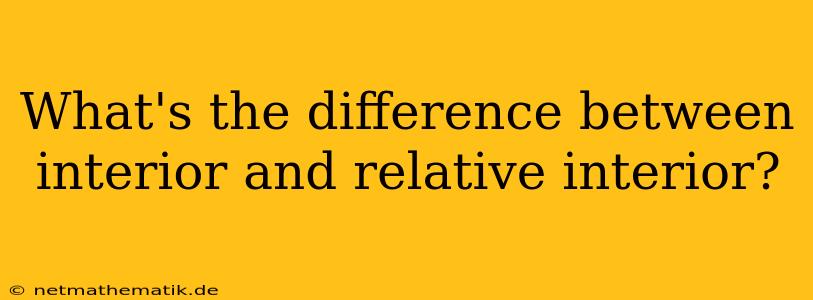In the realm of mathematics, particularly in the field of topology and analysis, the concepts of interior and relative interior play a crucial role in defining and understanding the properties of sets within a given topological space. While they might seem similar at first glance, a subtle yet important distinction separates them. This article aims to clarify the difference between these two concepts, providing a comprehensive understanding of their definitions, properties, and applications.
Interior vs. Relative Interior: A Fundamental Distinction
The concept of interior is defined for sets within a topological space. It essentially refers to the set of all points within the set that are not on the boundary. In other words, the interior consists of points that have a neighborhood entirely contained within the set. This means that if a point is in the interior, there is a "buffer zone" around it that is also part of the set.
Relative interior takes a different approach. It focuses on the interior of a set relative to another set, often a larger set containing the first set. This means that the relative interior of a set is defined as the interior of that set when considered as a subset of the larger set.
Visualizing the Difference
To illustrate the difference between interior and relative interior, consider a simple example: a closed interval [0, 1] on the real line. The interior of this interval is (0, 1), excluding the endpoints 0 and 1. However, if we consider the interval [0, 1] as a subset of the larger interval [0, 2], the relative interior of [0, 1] with respect to [0, 2] becomes (0, 1), which is the same as its interior. This difference arises because the relative interior considers the larger set's topology, while the interior only considers the topology of the original set.
Understanding the Definitions
Interior:
Formally, the interior of a set S in a topological space X, denoted as int(S), is defined as the union of all open sets contained within S.
In other words:
int(S) = {x ∈ S | there exists an open set U such that x ∈ U ⊆ S}
This definition highlights the fact that a point is in the interior if and only if there is a "neighborhood" around that point that is entirely contained within the set.
Relative Interior:
The relative interior of a set S in a topological space X, relative to a set T where S ⊆ T, is defined as the interior of S when considered as a subset of T. It is denoted as ri(S, T).
Formally:
ri(S, T) = {x ∈ S | there exists an open set U in T such that x ∈ U ⊆ S}
The difference lies in the open set U. In the definition of interior, U must be an open set in X, the entire topological space. In the definition of relative interior, U must be an open set in T, the larger set containing S.
Properties of Interior and Relative Interior
Both interior and relative interior exhibit several important properties:
Interior:
- Empty Set: The interior of the empty set is the empty set itself.
- Union: The interior of the union of two sets is at least as large as the union of their interiors.
- Intersection: The interior of the intersection of two sets is equal to the intersection of their interiors.
Relative Interior:
- Empty Set: The relative interior of the empty set is the empty set itself.
- Union: The relative interior of the union of two sets is at least as large as the union of their relative interiors.
- Intersection: The relative interior of the intersection of two sets is equal to the intersection of their relative interiors.
These properties demonstrate the consistency and logical structure of these concepts within the framework of topology.
Applications in Mathematics
Interior and relative interior are fundamental concepts with a wide range of applications across various mathematical disciplines, including:
- Topology: They are crucial for defining topological properties of sets, such as openness, closedness, and connectedness.
- Analysis: They are used in defining concepts like continuity, differentiability, and integration of functions.
- Optimization: The interior and relative interior of sets play a significant role in constraint qualification conditions and optimization problems.
- Geometry: They are applied in defining properties of geometric objects, such as convexity and polytopes.
Conclusion
The difference between interior and relative interior is subtle but crucial. While both concepts define sets of points within a given set, the interior considers the topology of the entire space, while the relative interior considers the topology of a larger set containing the original set. These distinctions are essential for understanding the nuances of topological and analytical concepts and for solving problems in various mathematical fields. By grasping the definitions and properties of these concepts, mathematicians gain a deeper understanding of the structures and relationships within sets and topological spaces.
